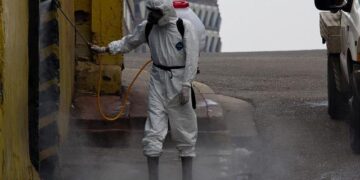Ecologists don’t agree on what makes for the healthiest lawn. And restoring biodiversity requires more than doing less.
By
Peter Andrey Smith/Undark
|
Published May 17, 2024 10:33 AM EDT

#NoMowMay may just be a hashtag. DepositPhotos
This article was originally featured on Undark.
In 2020, the Wisconsin city of Appleton brought No Mow May to the United States. Each spring, by temporarily forgoing mowing and letting residential lawns grow with flowers, residents could support bees and other insect pollinators, proponents claimed. Indeed, they even said the practice was backed by their own published scientific study.
But a little more than two years later, critics turned up severe flaws in the work conducted in Appleton, and the study was formally retracted.
To Sara Stricker, a plant pathologist, it was another sign of anti-grass zealotry gone awry. In spring 2023, she launched a campaign criticizing No Mow May, saying the movement was misguided and delivered little on its intended value. But, she said, people don’t typically want to digest the science behind such a thing: “They just want the quick hashtag and a little sign with a cute little icon in it that makes them feel good.”
Before long, Stricker’s inbox filled with hate mail. For instance, she said she was accused of being in the pocket of industry. Stricker works as a communications and outreach coordinator for the Guelph Turfgrass Institute, outside of Toronto, which has outdoor research fields for the express purposes of studying the green stuff that covers lawns and sports fields and golf fairways. She maintains that she was just trying to start a conversation and acknowledges that her institution draws support from chemical manufactures and the lawn care industry — which is not uncommon in agricultural and horticultural research. But, she said, “None of us are walking around with devil horns saying, ‘Woohaha, I want to kill something today.’ We’re all in it because we like being outside, we like doing sports, we like nature.”
“They just want the quick hashtag and a little sign with a cute little icon in it that makes them feel good.”
Stricker had not exactly called for a Blitzkrieg on biodiversity. In fact, she encouraged people to plant a wider range of species if they wanted to help support wildlife. (Other experts have proposed similar measures.) In an experiment described in GreenMaster, a trade publication for Canadian golf course managers, her institute found that No Mow May was unlikely to make much of a difference: Over the course of the one-month study, unmowed plots of Kentucky bluegrass did not substantially support more flowers compared to plots mowed at two-and-a-half inches.
But why had experts on grass, at a premier grass-growing institute in North America, come out swinging against something as seemingly innocuous as No Mow May? If something as simple as not mowing for a month doesn’t do much for biodiversity, then what lawn-care practices — from tearing up sod entirely to planting lush wildflower meadows — are supported by data and research?
Lawns represent one of the largest, fastest growing landscapes in the U.S. These ecosystems — water-hungry, energy-intensive monocultures — extend far beyond the picket fence, including highway medians, cul-de-sacs, corporate office parks. De facto lawns also exist under solar arrays, on soccer fields, and in city parks. In the U.S., it’s a landmass that, by some estimates, covers an area about the size of Iowa.
The concept of well-manicured, tightly shorn spaces originated as a status symbol in Europe. Colonizers introduced grasses in an effort to replicate the places they left. By the 18th century, wealthy Americans began tending formal lawns, and much later, particularly in the wake of post-war industrialization and suburban development, the masses followed suit.
 A 1917 photograph of a garden in Rhode Island, taken to illustrate the popular poem, “The Glory of the Garden,” by Rudyard Kipling. The concept of well-manicured, tightly shorn spaces originated as a status symbol in Europe, which wealthy Americans began to replicate in the 18th century. Visual: Frances Benjamin Johnston/Library of Congress
A 1917 photograph of a garden in Rhode Island, taken to illustrate the popular poem, “The Glory of the Garden,” by Rudyard Kipling. The concept of well-manicured, tightly shorn spaces originated as a status symbol in Europe, which wealthy Americans began to replicate in the 18th century. Visual: Frances Benjamin Johnston/Library of Congress
But by the 1980s, the lawn began to lose its luster as nonprofit organizations and individuals increasingly called for its eradication. In 1989, the writer Michael Pollan published a landmark essay “Why Mow?” which indelibly described lawns as “nature purged of sex and death.” In some circles, lawns have come to exemplify a consumptive sensibility. “Over the past 50 years, we’ve slowly fallen out of love with lawns,” The Washington Post reported in 2022. “They began to signal waste, disregard, disharmony, homogeneity, gentrification, zombie Boomerism.”
The imperatives to remove lawns span a range of concerns: managing scarce water, building climate resiliency, boosting biodiversity, and even supporting mental health. As J. Leighton Reid, a restoration ecologist at Virginia Tech, put it, any change is probably better than the status quo. “It almost goes without needing evidence to say that a lawn has lower biodiversity than a native ecosystem,” he said. “I mean, that’s just inevitably going to be the case.”
But what actually works? Quick-fix lawn-conversion solutions encounter several problems in practice. For one, contemporary agricultural and horticultural research often focuses on commercial production on a large scale. (Private firms, such as those marketing chemical fertilizers and herbicides, overwhelmingly bankroll R&D in the U.S.) In contrast, ornamental lawn maintenance falls to practitioners — DIYers and hired professionals alike — who learn from experience and tend to focus on what looks best. Advocates also take matters into their own hands, although no single foolproof method for replacing the lawn and transforming it into a more functional ecosystem exists.
Perhaps the most obvious and most enduring problem rests with grass itself. Grasses generally have a number of reproductive methods and survival mechanisms that make them hard to wipe out. As Laura Jackson, director of the University of Northern Iowa’s Tallgrass Prairie Center, which conducts large-scale prairie restoration, put it: “You can drive a stake through its heart, you can put on the garlic, you can get out the silver cross or whatever, and you’re still going to have that stuff.”
Old habits die hard, too. When it comes to lawns — to walk barefoot on a soft carpet of grass, the sensibility, the institution of lawn care, the whole way of thinking — the practice seems indestructible. And so, some people fire up gas-powered mowers while their neighbors stake No Mow May signs in their lawns gone “wild.” Surely, there has to be a middle ground.
In ecological circles, there is a consensus for why the traditional lawn is perhaps long overdue for disruption, as monoculture grasses do not support much life. Simply put, lawns are deceptively lush: They look green, but are not figuratively “green” in terms of supporting a functional ecosystem.
One study on 159 residential yards in the Washington D.C. area found that, even in the leafy suburbs, an area rich with flowering plants, the landscape filled with nonnative vegetation lacked resources for birds. These nonnative plant species supported fewer insects regularly eaten by one beloved native bird species, the Carolina chickadee. In essence, the suburban landscape doubled as a food desert for the birds.
Hence, the impetus to convert. The best way to do so, however, is unclear. Looking at grasslands in Virginia, for instance, one master’s thesis study suggests that native wildflowers established more consistently when herbicide killed the existing grass completely (rather than seeding the wildflowers with no grass removal). Another Ph.D. student found evidence that the resulting level of native plant diversity in restored grasslands represents a pale facsimile compared to grassland that remained relatively undisturbed.
“It almost goes without needing evidence to say that a lawn has lower biodiversity than a native ecosystem. I mean, that’s just inevitably going to be the case.”
Reid, the Virginia Tech restoration ecologist who oversaw these studies, said he’s not sure how well the results translate since the studies focused on large-scale post-agricultural production systems. But one takeaway, given that native species fare better with less competition from grasses, is that it’s a case for clearly delineated strips that spatially separate grass from native plantings.
So, it’s not that there is disagreement over the why. Lawns could stand to benefit from greater biodiversity. But it’s the how that should happen — from grass-smothering mulches to sod-busting mechanical tools to chemical herbicides.
The lack of one-size-fits-all prescriptive advice isn’t just a matter of the heterogeneity of the landscape — the average rainfall and climate in Virginia is not the same as, say, southern California — but also of favoritism on an institutional scale. Financial incentives focus on research related to the commercial production of food; Reid, meanwhile says there should be no less imperative to study lawn conversion with an eye towards biodiversity. That’s unlikely, though. His research, in part, grew out of an effort to create pastures that helped prevent cows from getting sick from eating nonnative grasses in the summer. “If we pitched that as a lawn transformation study,” he said, “I don’t think they would have received it as well as pitching it as a cattle production study.”
Out in the Corn Belt, Jackson, at the Tallgrass Prairie Center, which provides seeds and technical assistance for plantings along public roadsides in Iowa, contends that urban lawns probably amount to a rounding error in terms of, say, providing sustenance for migratory butterflies. “It’s absolutely of no significance whatsoever from the point of view of monarch populations,” she said. “From a political point of view, from the point of view of people caring about monarchs, if that were to translate into political action, that’d be great, that would be significant. But from the point of view of water quality or number of stems of milkweed, it doesn’t move a needle at all.”
Still, the institute’s research has some potentially useful findings. Jackson’s research on seeding milkweed (the host plant for monarch caterpillars) in road ditches with existing vegetation showed abysmal results without applying herbicides, such as Roundup, prior to planting. “You get precisely no plants,” Jackson said. “You use Roundup once, you get a few more, and, if you round it up a couple of times, you get a few more.”
While Jackson added that she personally prefers not to use chemical controls, which are mired in controversy because of their deleterious effects on soil, insect, and human health, the amounts of herbicides used annually in wildflower restoration amount to little when compared against the high volumes sprayed on crops like corn and soybeans. The reality is there’s little prairie left, and it isn’t regenerating on its own. “We’ve done a lot of damage and it’s not going to be easy to undo that damage,” she said.
Jackson championed restoration and her blanket advice for others was simply to underscore the uncertainty: “A great deal of humility is called for in this business.”
“This isn’t science. This is just someone’s anecdotal experience or some guru, self-proclaimed expert telling people what to do.’”
Meanwhile, Linda Chalker-Scott, a professor and extension urban horticulturist at Washington State University, suggested grass-killing herbicides only be used as a last resort. Chalker-Scott has something of a reputation for debunking “horticultural myths.” Her initial skepticism piqued when she was reading a textbook on landscaping and came across some fishy citations: “So that’s when I started thinking, ‘Well, where is this information coming from?’ And then tracing it back and saying, ‘Well, this isn’t science. This is just someone’s anecdotal experience or some guru, self-proclaimed expert telling people what to do.’”
She generally cautions against digging up grass (it removes organic matter and disturbs the soil), and has co-authored one study that found flaws with covering a yard with cardboard and other sheet mulches in order to smother and kill off existing vegetation. In terms of reducing the movement of gasses from the soil into the atmosphere and vice versa, she said that black plastic (which kills unwanted plants by solarization and is used by organic practitioners) is worse than using 12 inches of coarse wood chips. Mulching grasses when dormant, she said, “is the single best way to prepare soil for planting, to get rid of weeds, and to pretty much improve and retain soil tilth.”
Chalker-Scott also made it clear she wasn’t calling for the wholesale removal of lawns. “I don’t hate lawns. I like functional lawns. And sod lawns,” she said, describing those planted with a roll of turf, “are not functional.”
Perhaps there is no one true path carved out of the grass. About 10 years ago, Nancy Shackelford, an ecologist at the University of Victoria, co-authored a paper outlining nine principles for restoration. “We talked a lot in that 2013 paper about resilience and self-sustaining ecosystems, as in, like, ‘Take the humans out of it.’ And I don’t really aspire to that anymore.” Today, she said, the best laid plans involve restored ecosystems that people want to maintain. “Restoration is always about values. Always,” she said. “So, you can’t take that human piece out of restoration as much as you may try. You can’t pretend it’s just for nature.”
Ecology fundamentally lacks grand unifying theories, and her view reflects a larger shift. When the main restoration group, the Society for Ecological Restoration, updated its primer, for instance, the international conservation organization described restoration taking many shapes. Any step seemed like a good first step, Shackelford said, and, even what might appear like mere symbolic restoration of lawns can be beneficial. Still, she said, the international community sometimes implied that a restored ecosystem could and should take care of itself.
But she was less and less sure: “I actually think humans have a role to play in taking care of all ecosystems. It’s kind of our job at this point.”
>>> Read full article>>>
Copyright for syndicated content belongs to the linked Source : Popular Science – https://www.popsci.com/science/science-no-mow-may/






























